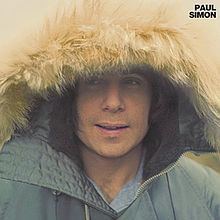Released January 24, 1972 | Length 34:03 Release date 24 January 1972 | |
 | ||
Recorded January to March 1971 at CBS Studios, San Francisco and NYC, Western Recorders, Los Angeles, Dynamic Sound Studios, Kingston and CBE Studios, Paris Similar Paul Simon albums, Folk rock albums | ||
Paul Simon is the second studio album by American singer-songwriter Paul Simon as a solo artist. It was released in January 1972, nearly two years after he split up with longtime musical partner Art Garfunkel. His first solo album was recorded in England in 1965 but remained unreleased in the U.S. (except for a brief period in 1969) until 1981, when it appeared in the 5-LP Collected Works boxed set. Originally released on Columbia Records, Paul Simon was then issued under the Warner Bros. label and is now back with Columbia through Sony. The album topped the charts in the United Kingdom, Japan and Norway and reached No. 4 on the U.S. Billboard Pop Albums. In 1986 it was certified platinum.
Contents
- Paul simon track 2 duncan
- History
- Reception
- Track listing
- Musicians
- Production and engineering
- Songs
- References
Paul simon track 2 duncan
History
Simon taught songwriting classes at New York University during the summer of 1971. Among the students he taught were two of the Roche sisters, Maggie and Terre, and singer-songwriter Melissa Manchester who remembers that Simon was nervous, listened to the students' songs and offered suggestions and criticism, often dissecting the lyrics and drawing comparisons with his own work while offering insights into his own work and sources of inspiration.
Simon traveled to San Francisco to record some demos and began to work with different musical styles for a proposed solo album, including Latin music, jazz, blues and reggae with the song "Mother and Child Reunion", recorded in Kingston, Jamaica). Guest musicians on the record included Stephane Grappelli, Ron Carter, and Airto Moreira. The music reflects Simon's interest in world music.
Several songs on the album, such as "Run That Body Down" (in which both "Paul" and "Peg" are mentioned by name) and "Congratulations", make reference directly or indirectly to his rocky marriage to Peggy (née Harper), which ended in divorce in 1975. Other themes include drugs and adolescence.
Reception
In a contemporary review for The Village Voice, Robert Christgau gave Paul Simon an "A+" and wrote, "this is the only thing in the universe to make me positively happy in the first two weeks of February 1972."
Critical praise was indeed widespread for this album, though some reviewers were put off by it. Noel Coppage, in Stereo Review, called it "undistinguished" and added, "I gather...this album is merely Simon's way of keeping his hand in while Garfunkel makes movies....I'm now wondering if Garfunkel's arranging work doesn't include sending Simon back to rewrite some of his songs before recording them." Despite Coppage's panning, the other Stereo Review critics went on to give the album one of its "Record Of The Year" awards. It was ranked No. 268 on the list of Rolling Stone's 500 Greatest Albums of All Time.
Track listing
All songs written by Paul Simon, except "Hobo's Blues" co-written by Stéphane Grappelli.
- "Mother and Child Reunion" – 3:05
- "Duncan" – 4:39
- "Everything Put Together Falls Apart" – 1:59
- "Run That Body Down" – 3:52
- "Armistice Day" – 3:55
- "Me and Julio Down by the Schoolyard" – 2:42
- "Peace Like a River" – 3:20
- "Papa Hobo" – 2:34
- "Hobo's Blues" – 1:21
- "Paranoia Blues" – 2:54
- "Congratulations" – 3:42
In July 2004, the album was re-issued on CD, which contained three included songs:
- "Me and Julio Down by the Schoolyard" (Demo – San Francisco 2/71) – 2:29
- "Duncan" (Demo – San Francisco 2/71)" – 2:48
- "Paranoia Blues" (Unreleased Version) – 3:14
Musicians
Production and engineering
Songs
1Mother and Child Reunion3:06
2Duncan4:43
3Everything Put Together Falls Apart2:02
